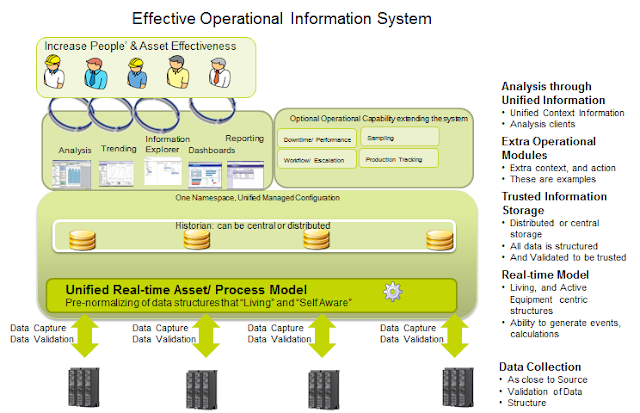How Pre Context/ Pre Normalizing vs Traditional Post Context DATA/ INFORMATION is critical to Operational Empowerment
Over the last couple weeks I have ranted on about what is happening that makes this Operational Empowerment Revolution not a nice to have but a necessary in today’s changing/ rotating workforce. Then I sit in a room and listen to people about “just put a historian in and capture the data we will use it latter to tune the plant”. Yet in the next breadth the comment and vision of operational execution/ excellence with procedures and MES like execution is discussed. I feel cold in the seat, as the vision is correct, the passion is there, but the immediate execution will put them down a path to constrain their ability to go to vision.
So it was time to pipe up, and get up on the white board and enjoy myself in concepts and opportunity. The data centric model is not bad it works but it brings up shortfalls in ability to evolve to more proactive. I believe as the market moves more and more into all decisions in the NOW, traditional approaches to information systems will be good for analysis, tuning, and post actions, but that is not NOW.
As the worker no matter their role evolves every day to an increasingly Knowledge worker, performing actions and responsibilities beyond their traditional roles, the expectation is a more adaptive business. In the example above the CIO was describing a modern operational Now vision, yet applying a tradition post action solution. We have always heard the next step beyond intelligence and information is action, and this is so true, but the step beyond that is pre-emptive information/ condition and action in the NOW time frame.
The requirements for a information system today is seen in the diagram the key points are:
· You capture the data as close to source as possible for data integrity
· You validate (more that just bad data) but is the reading actually valid for the state of the process.
· The data is then put in context in a “Living agent/ object etc” that can bring in validate, but also do calculation/ kpis etc and generate events. The data is effectively transformed into information that can be stored and triggered into immediate action, but initiating an alarm, or workflow.
· The storage layer is the tradition historian which could be distributed or central, and could support Tiered but in a one name space created the layer below in the plat model, providing unique names and context.
· Operational extensions these are a series of programs/ modules which should extend the plant model with more information, valued context.
· Then the unifying information model that is accessed and interacted with through rich set of content and analysis clients.
This is vs the traditional Historian approach that captures data un validated and structured and does post normalization.
The pre approach seems more accommodating to evolution, value and ability to take actions in the now, it is also less risk, using a combination of System Platform with the historian built in.
It is time to rethink based upon the “job to Be Done “ today, and the context of the job, the technologies are available!
It is time to rethink based upon the “job to Be Done “ today, and the context of the job, the technologies are available!


No comments:
Post a Comment